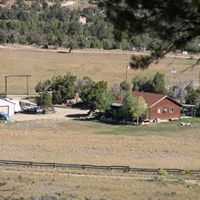Stephen W Stroud
age ~54
from Amherst, MA
- Also known as:
-
- Stephen W Hazzard
- Phone and address:
- 208 Snell St, Amherst, MA 01002
Stephen Stroud Phones & Addresses
- 208 Snell St, Amherst, MA 01002
- Grafton, MA
- 894 Neck Rd, Nobleboro, ME 04555 • 2075637710
- 70 Harrison Ave, Williamstown, MA 01267 • 4134584975
- 18 Water St, Williamstown, MA 01267 • 4134584975
- 163 Gale Rd, Williamstown, MA 01267 • 4134584975
- South Windsor, CT
- Thorndike, MA
- Geneva, NY
- Northampton, MA
Us Patents
-
Compounds And Methods For Inhibiting Mitotic Progression
view source -
US Patent:20140046055, Feb 13, 2014
-
Filed:Oct 3, 2012
-
Appl. No.:13/644216
-
Inventors:MILLENNIUM PHARMACEUTICALS, INC. - , US
Lloyd J. Payne - Cambridge, GB
Richard J. Boyce - Boxworth, GB
Todd B. Sells - Bellingham MA, US
Stephen G. Stroud - Medford MA, US
Stuart Travers - Meppershall, GB
Tricia J. Vos - Medford MA, US
Gabriel S. Weatherhead - Cambridge MA, US -
Assignee:MILLENNIUM PHARMACEUTICALS, INC. - Cambridge MA
-
International Classification:C07D 487/04
-
US Classification:540578
-
Abstract:This invention relates to compounds and methods for the treatment of cancer. In particular, the invention provides compounds that inhibit Aurora kinase, pharmaceutical compositions comprising the compounds, and methods of using the compounds for the treatment of cancer.
-
Process And Composition For Generation Of Acid
view source -
US Patent:59142138, Jun 22, 1999
-
Filed:Oct 6, 1997
-
Appl. No.:8/944284
-
Inventors:Jurgen M. Grasshoff - Hudson MA
John L. Marshall - Somerville MA
Richard A. Minns - Arlington MA
Socorro M. Ramos - North Andover MA
Stephen G. Stroud - Medford MA
Stephen J. Telfer - Arlington MA
Haixin Yang - Durham NC
Roger A. Boggs - Wayland MA
Eric S. Kolb - Acton MA -
Assignee:Polaroid Corporation - Cambridge MA
-
International Classification:G03C 1492
G03C 1494
G03C 176 -
US Classification:4302701
-
Abstract:A process for generation of acid uses a medium comprising a first acid-generating component capable of generating a first acid, and a secondary acid generator, this secondary acid generator being capable of thermal decomposition to form a secondary acid, the thermal decomposition of the secondary acid generator being catalyzed by the first acid. At least part of the medium is exposed to so as to cause formation of the first acid from the first acid-generating component; and the medium is then heated to cause, in the exposed part of the medium, acid-catalyzed thermal decomposition of the secondary acid generator and formation of the secondary acid. The secondary acid generator has a first site bearing a first leaving group and a second site bearing a second leaving group, the first leaving group being capable of protonation by the first acid, with expulsion of the first leaving group to form a cation which electrophilically adds to an unsaturated reagent bearing a proton at the site of addition and a proton-containing nucleophilic grouping at an adjacent site, following which said proton on the reagent is lost and the second leaving group is displaced by said nucleophilic grouping, the second leaving group, in combination with a proton, forming the secondary acid. Preferred variants of the process are of the types described in U. S. Pat. Nos. 5,286,612; 5,334,489; 5,395,736; 5,441,850 and 5,453,345.
-
Process And Composition For Generation Of Acid
view source -
US Patent:61106380, Aug 29, 2000
-
Filed:Nov 27, 1996
-
Appl. No.:8/757195
-
Inventors:Roger A. Boggs - Wayland MA
Jurgen M. Grasshoff - Hudson MA
Eric S. Kolb - Ipswich MA
John L. Marshall - Somerville MA
Richard A. Minns - Arlington MA
Socorro M. Ramos - North Andover MA
Stephen G. Stroud - Medford MA
Stephen J. Telfer - Arlington MA
Haixin Yang - Norwood MA -
Assignee:Polaroid Corporation - Cambridge MA
-
International Classification:C03C 1492
C03C 1494
C03C 176 -
US Classification:4302701
-
Abstract:A process for generation of acid uses a medium comprising a first acid-generating component capable of generating a first acid, and a secondary acid generator, this secondary acid generator being capable of thermal decomposition to form a secondary acid, the thermal decomposition of the secondary acid generator being catalyzed by the first acid. At least part of the medium is exposed to so as to cause formation of the first acid from the first acid-generating component; and the medium is then heated to cause, in the exposed part of the medium, acid-catalyzed thermal decomposition of the secondary acid generator and formation of the secondary acid. The secondary acid generator has a first site bearing a first leaving group and a second site bearing a second leaving group, the first leaving group being capable of protonation by the first acid, with expulsion of the first leaving group, followed by loss of a proton from the secondary acid generator to form an unstable intermediate, which then fragments with loss of the second leaving group, accompanied by either (a) loss of a second proton; or (b) addition of a proton-containing nucleophile, followed by loss of a proton, the second leaving group, in combination with a proton, forming the secondary acid. Preferred variants of the process are of the types described in U. S. Pat. Nos. 5,286,612; 5,334,489; 5,395,736; 5,441,850 and 5,453,345.
-
Benzpyrylium Squarylium And Croconylium Dyes, And Processes For Their Preparation And Use
view source -
US Patent:59773510, Nov 2, 1999
-
Filed:May 20, 1993
-
Appl. No.:8/065350
-
Inventors:Peter K. Chu - Acton MA
Serajul Haque - Braintree MA
Anthony J. Puttick - Arlington MA
Socorro M. Ramos - Belmont MA
Robert P. Short - Arlington MA
Stephen G. Stroud - Medford MA
Stephen J. Telfer - Arlington MA
Michael J. Zuraw - Arlington MA -
Assignee:Polaroid Corporation - Cambridge MA
-
International Classification:C07D34500
C07D33504
C07D31104 -
US Classification:540 1
-
Abstract:Dyes comprising an inner salt of a compound of the formula: Q. sup. 1 =Z-Q. sup. 2 wherein: Q. sup. 1 is a 4-(benz[b]-4H-pyrylium)methylidene, 4-(benz[b]-4H-thiopyrylium)methylidene or 4-(benz[b]-4H-selenopyrylium)methylidene grouping; Z is a 1,3-(2-hydroxy-4-oxo-2-cyclobutylidene) hydroxide or 1,3-(2-hydroxy-4,5-dioxo-2-cyclopentylidene) hydroxide ring; and Q. sup. 2 is a 4-(benz[b]-4H-pyran-4-ylidene)methyl, 4-(benz[b]-4H-thiopyran-4-ylidene)methyl or 4-(benz[b]-4H-selenopyran-4-ylidene)methyl grouping; wherein at least one of the groupings Q. sup. 1 and Q. sup. 2 carries at its 2-position a substituent in which a non-aromatic carbon atom is bonded directly to the benzpyrylium, benzthiopyrylium or benzselenopyrylium nucleus, subject to the proviso that if this 2-substituent contains an aromatic nucleus, this aromatic nucleus is not conjugated with the benzpyrylium, benzthiopyrylium or benzselenopyrylium nucleus to which it is attached, are useful as visible and near infra-red absorbers, having high extinction coefficients and improved solubility in polymeric media.
-
Chrome Complexed Dye Developer Compounds And Photographic Products And Processes
view source -
US Patent:44812787, Nov 6, 1984
-
Filed:Oct 29, 1982
-
Appl. No.:6/437617
-
Inventors:Patrick F. King - Needham MA
Stephen G. Stroud - Brighton MA -
Assignee:Polaroid Corporation - Cambridge MA
-
International Classification:G03C 140
G03C 554
G03C 700
C09B 4500 -
US Classification:430225
-
Abstract:Novel chrome complexed azo and azomethine yellow dye developers which include a substantially colorless symmetrical ligand. Also disclosed are photographic products and processes which utilize the dye developers.
-
Benzpyrylium Squarylium And Croconylium Dyes, And Processes For Their Preparation And Use
view source -
US Patent:56270143, May 6, 1997
-
Filed:Jun 2, 1995
-
Appl. No.:8/460229
-
Inventors:Peter K. Chu - Acton MA
Serajul Haque - Braintree MA
Anthony J. Puttick - Arlington MA
Socorro M. Ramos - Belmont MA
Robert P. Short - Arlington MA
Stephen G. Stroud - Medford MA
Stephen J. Telfer - Arlington MA
Michael J. Zuraw - Arlington MA -
Assignee:Polaroid Corporation - Cambridge MA
-
International Classification:G03C 1725
G03C 1735
G03C 173 -
US Classification:430332
-
Abstract:Dyes comprising an inner salt of a compound of the formula: Q. sup. 1 =Z-Q. sup. 2 wherein: Q. sup. 1 is a 4-(benz[b]-4H-pyrylium)methylidene, 4-(benz[b]-4H-thiopyrylium)methylidene or 4-(benz[b]-4H-selenopyrylium)methylidene grouping; Z is a 1,3-(2-hydroxy-4-oxo-2-cyclobutylidene) hydroxide or 1,3-(2-hydroxy-4,5-dioxo-2-cyclopentylidene) hydroxide ring; and Q. sup. 2 is a 4-(benz[b]-4H-pyran-4-ylidene)methyl, 4-(benz[b]-4H-thiopyran-4-ylidene)methyl or 4-(benz[b]-4H-selenopyran-4-ylidene)methyl grouping; wherein at least one of the groupings Q. sup. 1 and Q. sup. 2 carries at its 2-position a substituent in which a non-aromatic carbon atom is bonded directly to the benzpyrylium, benzthiopyrylium or benzselenopyrylium nucleus, subject to the proviso that if this 2-substituent contains an aromatic nucleus, this aromatic nucleus is not conjugated with the benzpyrylium, benzthiopyrylium or benzselenopyrylium nucleus to which it is attached, are useful as visible and near infra-red absorbers, having high extinction coefficients and improved solubility in polymeric media.
-
Process And Composition For Generation Of Acid
view source -
US Patent:63070855, Oct 23, 2001
-
Filed:Jul 28, 2000
-
Appl. No.:9/627939
-
Inventors:Jurgen M. Grasshoff - Hudson MA
John L. Marshall - Somerville MA
Richard A. Minns - Arlington MA
Socorro M. Ramos - North Andover MA
Stephen G. Stroud - Medford MA
Stephen J. Telfer - Arlington MA
Haixin Yang - Norwood MA
Roger A. Boggs - Wayland MA
Eric S. Kolb - Acton MA -
Assignee:Polaroid Corporation - Cambridge MA
-
International Classification:C07F 902
-
US Classification:558208
-
Abstract:A process for generation of acid uses a medium comprising a first acid-generating component capable of generating a first acid, and a secondary acid generator, this secondary acid generator being capable of thermal decomposition to form a secondary acid, the thermal decomposition of the secondary acid generator being catalyzed by the first acid. At least part of the medium is exposed to so as to cause formation of the first acid from the first acid-generating component; and the medium is then heated to cause, in the exposed part of the medium, acid-catalyzed thermal decomposition of the secondary acid generator and formation of the secondary acid. The secondary acid generator has a first site bearing a first leaving group and a second site bearing a second leaving group, the first leaving group being capable of protonation by the first acid, with expulsion of the first leaving group to form a cation which electrophilically adds to an unsaturated reagent bearing a proton at the site of addition and a proton-containing nucleophilic grouping at an adjacent site, following which said proton on the reagent is lost and the second leaving group is displaced by said nucleophilic grouping, the second leaving group, in combination with a proton, forming the secondary acid. Preferred variants of the process are of the types described in U. S. Pat. Nos. 5,286,612; 5,334,489; 5,395,736; 5,441,850 and 5,453,345.
-
Ligands And Photographic Process
view source -
US Patent:44812868, Nov 6, 1984
-
Filed:Oct 29, 1982
-
Appl. No.:6/437611
-
Inventors:Patrick F. King - Needham MA
Stephen G. Stroud - Brighton MA -
Assignee:Polaroid Corporation - Cambridge MA
-
International Classification:G03C 554
G03C 142 -
US Classification:430441
-
Abstract:Novel compounds which are capable of forming a coordination complex with a metal and which include a silver halide developing substituent or a precursor thereof. The compounds are useful as silver halide developing agents and as intermediates for dye developers which are utilized in photographic applications.
Medicine Doctors

Stephen W. Stroud
view sourceSpecialties:
Oral & Maxillofacial Surgery
Work:
Piedmont Oral & Maxillofacial Surgery Center
2105 Braxton Ln STE 102, Greensboro, NC 27408
3362731000 (phone), 3362759919 (fax)
2105 Braxton Ln STE 102, Greensboro, NC 27408
3362731000 (phone), 3362759919 (fax)
Languages:
English
Description:
Dr. Stroud works in Greensboro, NC and specializes in Oral & Maxillofacial Surgery. Dr. Stroud is affiliated with High Point Regional Health.
Resumes

Academic Director
view sourceLocation:
Amherst, MA
Industry:
Education Management
Work:
John J Duggan Academy and John F Kennedy Academy
Academic Director
John J Duggan Academy
Dean of Curriculum and Instruction
John J Duggan Academy
Expeditionary Learning Magnet Resource Teacher
S.t.e.m Middle Academy Aug 2009 - Jun 2014
Expeditionary Learning Magnet Resource Teacher
The Leadership School at Kieve Mar 2008 - Mar 2009
Director
Academic Director
John J Duggan Academy
Dean of Curriculum and Instruction
John J Duggan Academy
Expeditionary Learning Magnet Resource Teacher
S.t.e.m Middle Academy Aug 2009 - Jun 2014
Expeditionary Learning Magnet Resource Teacher
The Leadership School at Kieve Mar 2008 - Mar 2009
Director
Education:
Lesley University 1996 - 1998
Master of Science, Masters, Education Hobart and William Smith Colleges 1989 - 1993
Bachelors, Bachelor of Arts, Mathematics
Master of Science, Masters, Education Hobart and William Smith Colleges 1989 - 1993
Bachelors, Bachelor of Arts, Mathematics
Skills:
Curriculum Design
Curriculum Development
Classroom
Teaching
Educational Leadership
Teacher Training
Tutoring
Educational Technology
Instructional Design
Staff Development
Non Profits
Grant Writing
Program Development
Community Outreach
Lesson Planning
Editing
Secondary Education
Elementary Education
Curriculum Mapping
Volunteer Management
Coaching
Event Planning
Program Evaluation
Project Based Learning
Science
Curriculum Assessment
Science Education
Professional Learning Communities
Powerpoint
Smartboard
Workshop Facilitation
Conflict Resolution
Classroom Management
Instructional Technology
Gifted Education
Technology Integration
Educational Consulting
Differentiated Instruction
Adult Education
International Education
K 12
Nonprofits
Curriculum Development
Classroom
Teaching
Educational Leadership
Teacher Training
Tutoring
Educational Technology
Instructional Design
Staff Development
Non Profits
Grant Writing
Program Development
Community Outreach
Lesson Planning
Editing
Secondary Education
Elementary Education
Curriculum Mapping
Volunteer Management
Coaching
Event Planning
Program Evaluation
Project Based Learning
Science
Curriculum Assessment
Science Education
Professional Learning Communities
Powerpoint
Smartboard
Workshop Facilitation
Conflict Resolution
Classroom Management
Instructional Technology
Gifted Education
Technology Integration
Educational Consulting
Differentiated Instruction
Adult Education
International Education
K 12
Nonprofits
Languages:
Spanish

Stephen Stroud
view source
Stephen Stroud
view source
Stephen Stroud
view sourceFlickr
Youtube
Classmates

Stephen Stroud
view sourceSchools:
Harrison High School Marietta GA 1995-1999

Stephen Stroud
view sourceSchools:
Glenwood High School Phenix City AL 1987-1991
Community:
Jimmy Jamison, Jane Day, Jimmy Everett

Stephen Stroud
view sourceSchools:
Leslie Lewis Elementary School Chicago IL 1973-1977
Community:
Robert Taylor, John Thompson, Terrie Therese, Charles Fau

Stephen Stroud (Overbey)
view sourceSchools:
Gurdon High School Gurdon AR 1998-2002
Community:
Alecia Bell, April Lindsey, Amanda Paull

Stephen Stroud | North Le...
view source
North Lenoir High School,...
view sourceGraduates:
Stephen Stroud (1967-1971),
Bridgett West (1994-1998),
Donald James (1967-1971),
Angela Simmons (1979-1983),
Wallace Koonce (1971-1975)
Bridgett West (1994-1998),
Donald James (1967-1971),
Angela Simmons (1979-1983),
Wallace Koonce (1971-1975)

Harrison High School, Mar...
view sourceGraduates:
Douglas Sheets (1992-1995),
Natalie Fanning (1993-1997),
Joy Kersey (1991-1994),
Stephen Stroud (1995-1999),
Tina Hillesheim (1992-1996)
Natalie Fanning (1993-1997),
Joy Kersey (1991-1994),
Stephen Stroud (1995-1999),
Tina Hillesheim (1992-1996)

Stephen Stroud
view source
Steve Stroud
view source
Stephen Stroud
view source
Stephen Alan Stroud
view source
Stephen Stroud
view source
Stephen Stroud
view source
Stephen Stroud
view source
Stephen Stroud
view sourceGoogleplus

Stephen Stroud

Stephen Stroud

Stephen Stroud

Stephen Stroud
Myspace

Stephen Stroud - Vocalist
view sourceGet Report for Stephen W Stroud from Amherst, MA, age ~54

















